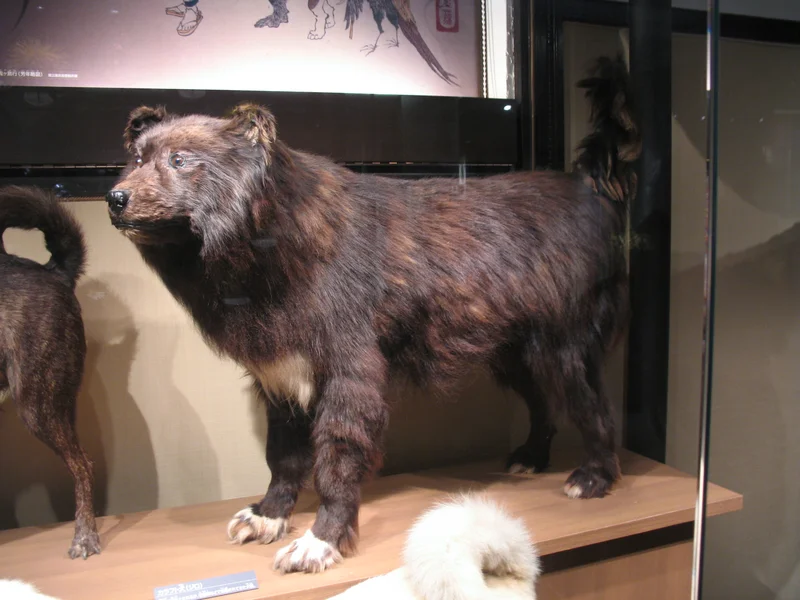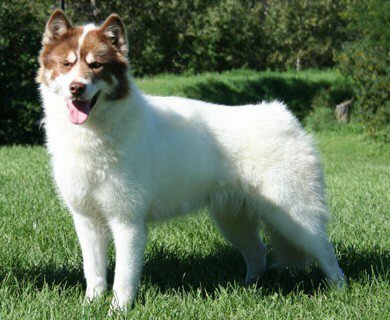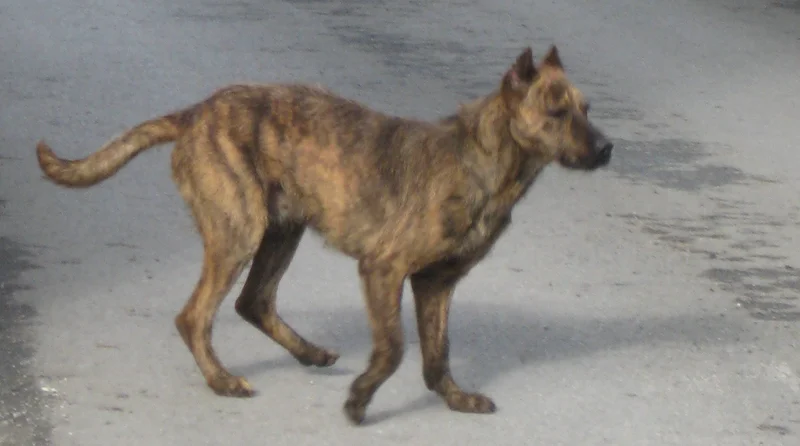Mackenzie River Husky
The Mackenzie River Husky is a medium-sized, energetic breed known for its endurance and friendly nature. Bred for sledding, they require ample exercise and thrive in active households.
Overview
🐕Breed Overview
✨Key Traits
💡What Makes Mackenzie River Husky Special
The Mackenzie River Husky's key traits include their remarkable endurance and strength, which make them exceptional sled dogs. They are highly social animals that thrive in a pack environment, whether with humans or other dogs.
Their playful nature and love for outdoor activities make them great companions for families who enjoy an active lifestyle. Additionally, their loyalty and affectionate behavior towards their owners make them beloved family pets.
However, their strong prey drive and tendency to escape require responsible ownership and training.
The Mackenzie River Husky is a striking breed known for its endurance, intelligence, and friendly demeanor. Originating from the harsh climates of Canada, these medium-sized dogs are descendants of the Siberian Husky, bred by Indigenous peoples for their remarkable ability to pull sleds and assist in hunting. With their thick double coats, erect ears, and expressive eyes, they are not only visually captivating but also incredibly resilient.
Their playful and adventurous spirit makes them excellent companions for active families and individuals who enjoy outdoor activities. Mackenzie River Huskies thrive on exercise, requiring at least 90 minutes of vigorous activity each day to keep them physically and mentally stimulated. They excel in various canine sports, including sledding, agility, and skijoring, showcasing their natural athleticism and intelligence.
Despite their independent nature, they are known for their affectionate bonds with their families, making them loving pets. However, potential owners should be prepared for their strong prey drive and tendency to escape, necessitating secure fencing and consistent training. Overall, the Mackenzie River Husky is a breed that embodies the spirit of adventure, loyalty, and resilience, making them a cherished addition to any active household.
🎉Fun Facts
Mackenzie River Huskies are known for their striking blue or heterochromatic eyes, which add to their unique appearance.
These dogs are known for their friendly disposition and often get along well with children and other pets when properly socialized.
They have a strong instinct to run, making them excellent escape artists; a secure fence is essential.
Breed Characteristics
Family & Friends
Good Behavior
Get Up & Go
Household Harmony
Temperament & Personality
✨Key Traits
🐕Core Temperament
Mackenzie River Huskies are generally friendly, energetic, and intelligent dogs. They are known for their playful and adventurous spirit, making them great companions for active families.
Their loyalty and affectionate nature make them well-suited for family life, as they enjoy being part of the household. However, their independent streak can lead to stubbornness, requiring consistent training and socialization.
They are typically good with children and other pets, but their strong prey drive means supervision is necessary around smaller animals.
💫Personality Profile
Mackenzie River Huskies are known for their energetic and playful nature. They are friendly and affectionate with their families, often forming strong bonds with their human companions.
These dogs thrive on social interaction and enjoy being part of family activities. While they can be independent and sometimes stubborn, they are also intelligent and eager to please, making training a rewarding experience when approached with patience and consistency.
Their playful demeanor means they enjoy games and outdoor activities, making them ideal companions for active families.
🔊Vocal Tendencies
Mackenzie River Huskies are known to be vocal dogs, often expressing themselves through barking, howling, and other sounds. They may bark to alert their owners of strangers or when they are excited.
While they are not excessive barkers, their vocalizations can be more pronounced when they are bored or seeking attention. Owners should be prepared for some level of noise, especially if the dog is left alone for extended periods.
Affection & Social Traits
Energy & Activity
Communication Style
Care Requirements
🏃♂️Exercise Requirements
Daily Exercise
Mackenzie River Huskies are highly active and energetic dogs that require a significant amount of exercise to maintain their physical and mental health. Ideally, they should engage in at least 90 minutes of vigorous exercise each day, which can include activities such as running, hiking, or playing fetch. These dogs thrive on high-intensity activities that challenge their endurance and strength, reflecting their heritage as sled dogs.
For puppies, shorter, more frequent play sessions are recommended to prevent overexertion, while adult dogs benefit from longer, sustained exercise sessions. Senior dogs may require less intense exercise but still need regular activity to keep them healthy and engaged. Regular exercise not only helps manage their weight but also reduces the risk of behavioral issues stemming from boredom or pent-up energy.
Insufficient exercise can lead to destructive behaviors, anxiety, and obesity, making it crucial for owners to prioritize their exercise needs.
Preferred Activities
🏠Living & Adaptability
Space Requirements
Mackenzie River Huskies require ample space to thrive, ideally a large yard or access to open areas where they can run freely. They are not well-suited for apartment living due to their high energy levels and need for exercise.
In urban settings, owners must ensure they have access to parks or open spaces for daily exercise. A secure, fenced area is essential, as these dogs are known for their ability to escape and roam.
In rural environments, they can enjoy the freedom to explore and engage in natural behaviors, which is beneficial for their overall well-being.
Climate Preference
🍲Feeding Guide
Schedule
Food Types
Portion Size
Special Nutritional Needs
Mackenzie River Huskies may benefit from a diet rich in protein and healthy fats to support their active lifestyle. It's essential to monitor their weight and adjust portions accordingly, especially during shedding seasons when their metabolism may change. Some individuals may have food sensitivities, so it's advisable to consult with a veterinarian for personalized dietary recommendations.
✨Grooming Requirements
Grooming Overview
The Mackenzie River Husky has a thick double coat that requires regular grooming to keep it healthy and free of mats. During shedding seasons, which occur twice a year, daily brushing is recommended to manage loose fur.
Outside of shedding periods, brushing once a week is sufficient. Use a slicker brush and an undercoat rake to effectively remove dead hair and prevent matting.
Bathing should be done as needed, typically every few months, to maintain coat cleanliness without stripping natural oils. Regular nail trimming and dental care are also important aspects of their grooming routine.
Care Schedule
Brush weekly, daily during shedding seasons, bathe as needed (every 1-3 months), trim nails every 2-4 weeks.
Health Profile
⚕️Health Care
Routine health care is crucial for extending the lifespan of Mackenzie River Huskies. Regular veterinary check-ups, vaccinations, and preventive treatments for parasites are essential.
Early detection of health issues through routine examinations can lead to more effective management and treatment. Owners should also be proactive in monitoring their dog's weight, dental health, and overall well-being, adjusting care routines as needed throughout their life stages.
Health Issues Overview
⏳Average Lifespan
Genetic Factors
Genetics play a significant role in the lifespan of Mackenzie River Huskies. Responsible breeding practices that prioritize genetic diversity can help reduce the risk of hereditary health issues.
Potential owners should seek reputable breeders who conduct health screenings for common genetic conditions, ensuring that the puppies are less likely to inherit serious health problems. Understanding the breed's genetic background can help owners make informed decisions about their dog's health and care.
Living Conditions
The lifespan of a Mackenzie River Husky can be influenced by various environmental factors, including housing conditions, climate, and social interactions. Dogs living in colder climates tend to thrive better due to their thick coats, while those in warmer areas may struggle with heat.
Providing a stimulating environment with plenty of exercise and socialization can enhance their overall health and longevity. Regular veterinary care, a balanced diet, and mental stimulation through training and activities are essential for promoting a long, healthy life.
🏥Common Health Issues
Hip Dysplasia
Warning Signs
🔬Diagnosis
Veterinarians typically diagnose hip dysplasia through physical examinations and X-rays.
💊Treatment
Weight management, pain relief medications, and in severe cases, surgical intervention.
📝Management Tips
Maintain a healthy weight, provide joint supplements, and engage in low-impact exercises.
Progressive Retinal Atrophy (PRA)
Warning Signs
🔬Diagnosis
Diagnosis is made through veterinary eye examinations and genetic testing.
💊Treatment
Currently, there is no cure; management focuses on adapting the environment.
📝Management Tips
Regular veterinary check-ups to monitor eye health and adapt living conditions as needed.
Canine Glaucoma
Warning Signs
🔬Diagnosis
Diagnosis is made through veterinary eye examinations, measuring intraocular pressure.
💊Treatment
Medications to reduce intraocular pressure and, in some cases, surgical intervention.
📝Management Tips
Regular eye check-ups and prompt treatment of any eye issues.
🛡️Preventive Care
🔬Hip Evaluation
Hip Evaluation assesses the hip joints for dysplasia and other abnormalities, crucial for maintaining joint health in active breeds.
📅 Annually after 2 years of age.
🔬Ophthalmic Examination
Eye Examination checks for hereditary eye conditions, ensuring early detection of issues like PRA and glaucoma.
📅 Every 1-2 years, or as recommended by a veterinarian.
🔬Thyroid Panel
Thyroid Testing evaluates thyroid function, which can affect energy levels and overall health.
📅 Annually after 5 years of age.
Training
🧠Intelligence & Trainability
💪Work Drive
Mackenzie River Huskies have a strong work drive, stemming from their history as sled dogs. They require regular mental stimulation and physical challenges to keep them happy and healthy.
Activities such as agility training, sledding, and interactive games can fulfill their need for tasks. Without sufficient engagement, they may become bored and exhibit destructive behaviors.
Providing them with jobs or activities that challenge their intelligence is essential for their overall well-being.
⚠️Training Considerations
Mackenzie River Huskies can present some behavioral challenges due to their high energy levels and independent nature. Common issues include stubbornness, a tendency to escape, and a strong prey drive, which may lead them to chase smaller animals.
To overcome these challenges, consistent training and socialization from an early age are essential. Positive reinforcement methods work best, as these dogs respond well to rewards and praise.
Engaging them in mentally stimulating activities can also help mitigate behavioral problems. Owners should be prepared for a learning curve, as these dogs may require patience and persistence during training sessions.
📝Training Tips
Training a Mackenzie River Husky requires a firm yet gentle approach. Start with basic obedience commands and gradually introduce more complex tasks.
Consistency is key, as these dogs thrive on routine. Incorporating play into training sessions can keep them engaged and motivated.
Socialization is crucial, exposing them to various environments, people, and other animals to develop their confidence and reduce potential aggression. Consider enrolling in obedience classes or working with a professional trainer familiar with the breed to ensure effective training.
History & Heritage
📜Origin Story
The Mackenzie River Husky originated in the Mackenzie River region of Canada, where Indigenous peoples relied on these dogs for transportation and hunting in the Arctic. The breed's lineage can be traced back to the Siberian Husky, which was brought to North America by the Chukchi people.
These dogs were bred to withstand extreme cold and perform demanding tasks, such as pulling sleds over long distances. Their introduction to the gold rush era in Alaska further solidified their status as essential working dogs.
The Mackenzie River Husky's ability to thrive in harsh conditions and their strong bond with humans have made them a cherished part of the cultural fabric of northern communities.
⏳Development History
The Mackenzie River Husky is a descendant of the Siberian Husky, developed by the Chukchi people of northeastern Siberia. Over time, these dogs were bred for their strength, endurance, and ability to work in harsh conditions.
The breed was introduced to North America during the gold rush, where they quickly became popular as sled dogs due to their speed and agility. The Mackenzie River Husky has retained many of the characteristics of its ancestors, including a thick double coat, strong build, and friendly disposition.
Breeding practices have focused on maintaining these traits while also enhancing their suitability as family pets. The breed has evolved to adapt to various environments, making them versatile working dogs and loyal companions.
🛡️Purpose & Historical Role
Historically, the Mackenzie River Husky was bred for sledding and hunting, playing a crucial role in the survival of Indigenous peoples in the Arctic. They were used to pull sleds over long distances, transport goods, and assist in hunting game.
Their endurance and strength made them invaluable companions in the harsh Arctic environment. In modern times, they continue to excel in sled dog racing and other canine sports, while also serving as loyal family pets.
🏺Cultural Significance
The Mackenzie River Husky holds a significant place in the cultural heritage of the Indigenous peoples of Canada, particularly the Inuit and Chukchi tribes. These dogs were essential for survival in the harsh Arctic environment, serving as sled dogs that facilitated transportation and hunting.
Their resilience and adaptability have made them symbols of endurance and companionship in these communities. The breed's historical role in exploration and trade routes across the Arctic has also contributed to its cultural importance, as they were instrumental in the success of many expeditions, including those led by famous explorers.
Today, the Mackenzie River Husky is celebrated not only for its working abilities but also as a beloved family pet, embodying the spirit of adventure and loyalty.
Conservation Status
This breed is less common but has stable populations in certain regions.









